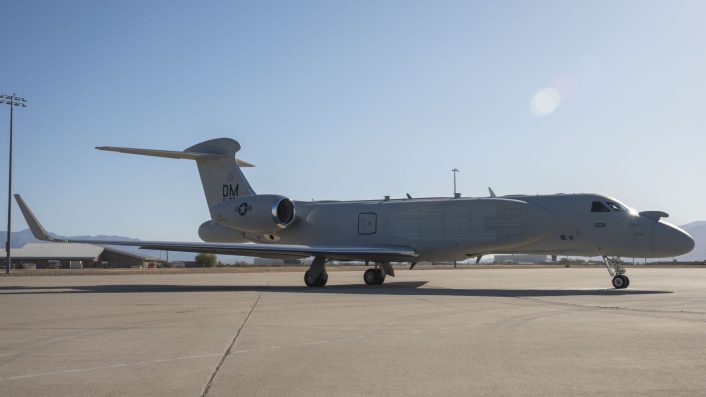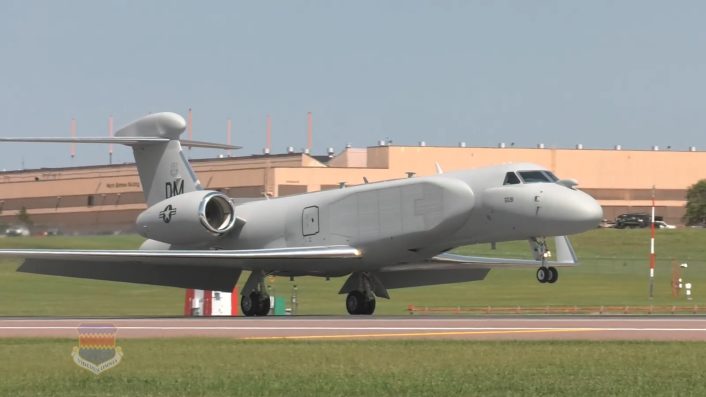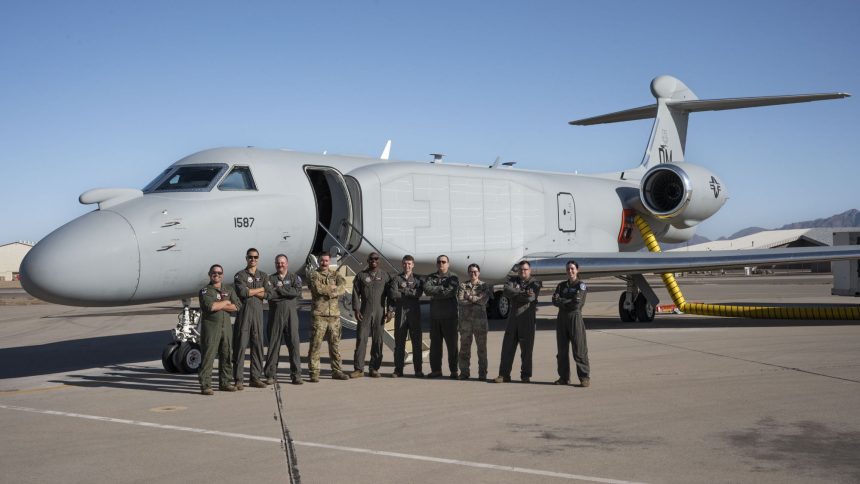The 43rd Electronic Combat Squadron flew the first mission training sortie for the EA-37B on May 2, 2025, says the service, referring to the Compass Call mission.
An EA-37B Compass Call aircraft, the U.S. Air Force’s newest dedicated standoff airborne electronic attack aircraft, assigned to the 43rd Electronic Combat Squadron (ECS), flew its first mission training sortie on May 2, 2025, at Davis-Monthan Air Force Base (AFB) in Arizona, said a press release. This development follows the delivery of the first aircraft on Aug. 23, 2024.
Although the 43rd ECS and the 55th Electronic Combat Group (ECG) are based at Davis-Monthan AFB, they report to the 55th Wing at Offutt AFB in Nebraska. The 55th ECG and its subordinate 41st ECS and 43rd ECS are the sole operators of Compass Call aircraft in worldwide contingency operations, and are currently transitioning from the EC-130H to the new EA-37B.
Images released show that beside 19-5591, the first to be delivered, the airframe, 19-1587 was also involved in the drill. Five EA-37Bs have been delivered to date, with a total of ten EA-37Bs planned to be produced and assigned to the 55th ECG by 2028.
In that process, Gulfstream would modify the aircraft with the necessary fairings to accommodate the mission equipment from BAE Systems, while L3Harris would later install and integrate them. As for the older EC-130Hs, ten of the 14 airframes have already been retired, the USAF statement mentioned.

While not explicitly stated, the use of the phrasing “first official mission training sortie” implies that this is the first sortie used to train EA-37B crews on the Compass Call mission. In fact, the EA-37B has been flying pilot training sorties since its delivery last year and was spotted multiple times.
The nature of this first mission training sortie has not been mentioned or photographed, given the secrecy surrounding military electromagnetic spectrum (EMS) technologies. However, we can assume the 43rd ECS and 55th ECG are working on developing tactics for long-range standoff jamming, electronic surveillance and spoofing attacks, and would soon put the EA-37B to its limits, exploring the full-range of its capabilities.
The future of electronic warfare in action!
The 43rd ECS just flew the first training sortie for the EA-37B, a cutting-edge electromagnetic attack aircraft that provides enhanced capabilities to disrupt adversary networks and support our forces. 👇https://t.co/6QbrHVI80K pic.twitter.com/sMjq8eUphu
— Air Combat Command (@aircombatcmd) May 13, 2025
Critical technology before peer adversaries
Lt. Col. Jesse Szweda, 43rd ECS director of operations, called the EA-37B and the “professionals who support its mission” the “most recent evolution in a long history of Electro-Magnetic Spectrum (EMS) dominance for the ECG.” Szweda added “The capabilities of this platform are the cornerstone to addressing emerging threats in any AOR [Area of Responsibility] at any time.”

“The EA-37B sustains Joint Force military advantage in electromagnetic battlespace and builds a more lethal force by modernizing electromagnetic attack capabilities to deny peer competitors’ tactical networks and information ecosystems,” said the service to describe the innovation brought by the new platform.
The aircraft further “denies, degrades and disrupts adversary communications, information processing, navigation, radar systems and radio-controlled threats,” while also using “offensive counter-information and electromagnetic attack capabilities in support of U.S. and coalition tactical air, surface and special operations forces,” the statement added. This suggests heavy Communications Intelligence (COMINT) and Signals Intelligence (SIGINT) capabilities, beside Electronic Warfare (EW), making it a complete and wholesome EMS warfare aircraft.
“This EA-37B mission culminates years of planning and coordination between thousands of people spanning many organizations,” said Lt. Col. Tray Wood, 43rd ECS commander. “The hard work and dedication of these groups ensure the Electronic Combat Group is prepared for future conflict with the 43d Electronic Combat Squadron leading developments in the Electromagnetic Spectrum.”
⚡EA-37B: The future of electromagnetic warfare is here.
The EA-37B unleashes precision and power to wreak havoc on adversary decision makers.
Check out the latest article in @aviationweek to learn more: ➡️ https://t.co/7IXq5cfa6F#EA37B #ElectromagneticWarfare pic.twitter.com/fksd3WGMPx
— BAE Systems, Inc. (@BAESystemsInc) April 28, 2025
Dedicated EW aircraft with a separate crew fully focused on the task drastically multiply the capabilities of frontline combat aircraft with EMS capabilities, such as the U.S. Navy’s E/A-18G Growler which has a single rear-seated Electronic Warfare Officer (EWO). Although dedicated to the EMS role, these frontline aircraft also have a kinetic combat role and will therefore experience the limits of human endurance and cognitive abilities, during extremely complex missions, having multi-faceted threats.
In fact, as the U.S. Department of Defense’s only long-range, full-spectrum stand-off electromagnetic warfare jamming platform, the Compass Call plays a key role in the U.S. Suppression of Enemy Air Defense (SEAD) strategy, alongside the EA-18G Growler and the F-16CM Block 50/52 Fighting Falcon.
Other platforms
Having several crew members fully dedicated to the electronic warfare mission, without having to focus on the complex flying and weapons engagement tasks, maximizes the combined impact that can be brought down to bear on an opposing force. This is in addition to the redundancy the EA-37B offers in the EMS spectrum warfare in the event of losses.
Networking with other special mission aircraft operating under various realms of the EMS gamut is another approach. This is already envisaged by the Royal Australian Air Force (RAAF), which sees its MC-55A Peregrine COMINT and SIGINT aircraft, E-7A Wedgetail AEW&C aircraft, F-35A Lightning IIs and E/A-18G Growlers operating in a network in a mutually supportive, complementing role.
And finally – for me the most interesting one – the Y-9LG number 30211 …
(Images by LoveAirplanes via Oneninety from Weibo) pic.twitter.com/pmRfLmihQJ
— @Rupprecht_A (@RupprechtDeino) August 30, 2024
In the Indo-Pacific, for instance, the U.S. Air Force and the U.S. Navy would face the PLA Air Force’s Y-9LG electronic warfare platform, which has been assessed to be a standoff jamming and EW attack aircraft, targeting radar and communication emissions. That platform participated in China’s Falcon Strike drills with Thailand in Aug. 2024, catching the attention of observers, who noted Beijing fielding the advanced capability in the region as it anticipates a conflict with peer rival U.S.









